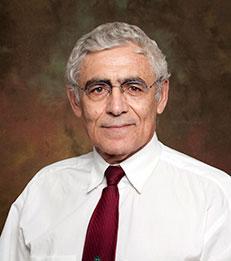Research Highlights
Menachem Brenner: Volatility Index Innovator
—

Menachem Brenner, NYU Stern Research Professor of Finance, is the co-inventor of the volatility index. Based on observable prices of traded index options, the index measures the stock market’s expectation of volatility over the ensuing 30 days. Relying on these foundational ideas, the Chicago Board Options Exchange (CBOE) subsequently created the volatility index, known as “VIX”, which is a registered trademark. Often referred to as the “fear index,” it is used by traders and academics worldwide. Many foreign exchanges publish such an index under the CBOE license.
Brenner and Professor Dan Galai, of the Hebrew University, laid the theoretical foundation of the VIX in a research paper in 1986. Their research proposing such an index, and financial instruments that could be based on it, was published in the academic article, “New Financial Instruments for Hedging Changes in Volatility,” in the July/August 1989 issue of the Financial Analysts Journal. In a subsequent paper, in the Journal of Derivatives, the two professors proposed a formula to compute the volatility index.
As Brenner and Galai wrote: “Our volatility index, to be named Sigma Index, would be updated frequently and used as the underlying asset for futures and options…A volatility index would play the same role as the market index plays for options and futures on the index.”
Over the next several years, the CBOE and its consultants further developed the index, with the aim of creating a volatility index most appropriate for trading derivatives. Subsequent to their 2003 development, VIX futures contracts began trading in 2004, followed by VIX options in 2006 and a slew of VIX based ETFs. Volatility derivatives have become one of the biggest derivatives markets globally.
Not always an academic, in 1985 professor Brenner took a leave to be a floor trader in options and futures for the New York Futures Exchange and New York Stock Exchange, an experience that enhanced his research and teaching in years to come. He was a member of the board of directors of the Tel Aviv Stock Exchange, in charge of creating the first derivatives exchange in Israel. Since then, he has become a derivatives and indices guru internationally, consulting and lecturing to major exchanges and institutions around the world, from Israel to the US, Switzerland, France, India, Brazil and Greece.
An award-winning financial writer, he has produced more than 60 scholarly articles, served as associate editor and referee of several financial journals, and co-founded the Review of Derivatives Research. At Stern, where he joined the faculty in 1990, Brenner teaches a popular course on futures and options. He also holds the position of director of the Masters in Global Finance program, a joint venture between Stern and the Hong Kong University of Science and Technology’s business school.
Brenner and Professor Dan Galai, of the Hebrew University, laid the theoretical foundation of the VIX in a research paper in 1986. Their research proposing such an index, and financial instruments that could be based on it, was published in the academic article, “New Financial Instruments for Hedging Changes in Volatility,” in the July/August 1989 issue of the Financial Analysts Journal. In a subsequent paper, in the Journal of Derivatives, the two professors proposed a formula to compute the volatility index.
As Brenner and Galai wrote: “Our volatility index, to be named Sigma Index, would be updated frequently and used as the underlying asset for futures and options…A volatility index would play the same role as the market index plays for options and futures on the index.”
Over the next several years, the CBOE and its consultants further developed the index, with the aim of creating a volatility index most appropriate for trading derivatives. Subsequent to their 2003 development, VIX futures contracts began trading in 2004, followed by VIX options in 2006 and a slew of VIX based ETFs. Volatility derivatives have become one of the biggest derivatives markets globally.
Not always an academic, in 1985 professor Brenner took a leave to be a floor trader in options and futures for the New York Futures Exchange and New York Stock Exchange, an experience that enhanced his research and teaching in years to come. He was a member of the board of directors of the Tel Aviv Stock Exchange, in charge of creating the first derivatives exchange in Israel. Since then, he has become a derivatives and indices guru internationally, consulting and lecturing to major exchanges and institutions around the world, from Israel to the US, Switzerland, France, India, Brazil and Greece.
An award-winning financial writer, he has produced more than 60 scholarly articles, served as associate editor and referee of several financial journals, and co-founded the Review of Derivatives Research. At Stern, where he joined the faculty in 1990, Brenner teaches a popular course on futures and options. He also holds the position of director of the Masters in Global Finance program, a joint venture between Stern and the Hong Kong University of Science and Technology’s business school.
